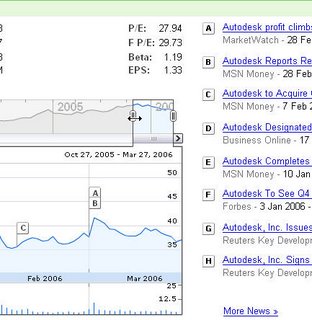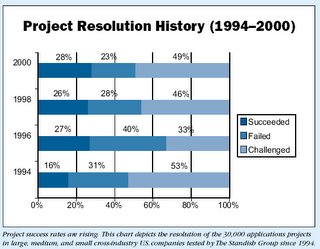 This is an new vis tool for showing stock performance correlated with news events: Google Finance (I pre-loaded my own company's data here). You can adjust the window you're seeing by size and location, and see the related stories associated with peaks and dips. It's kind of fun, although I wish they'd laid the page out a little nicer.
This is an new vis tool for showing stock performance correlated with news events: Google Finance (I pre-loaded my own company's data here). You can adjust the window you're seeing by size and location, and see the related stories associated with peaks and dips. It's kind of fun, although I wish they'd laid the page out a little nicer.
Monday, March 27, 2006
Google Finance.
 This is an new vis tool for showing stock performance correlated with news events: Google Finance (I pre-loaded my own company's data here). You can adjust the window you're seeing by size and location, and see the related stories associated with peaks and dips. It's kind of fun, although I wish they'd laid the page out a little nicer.
This is an new vis tool for showing stock performance correlated with news events: Google Finance (I pre-loaded my own company's data here). You can adjust the window you're seeing by size and location, and see the related stories associated with peaks and dips. It's kind of fun, although I wish they'd laid the page out a little nicer.
Sunday, March 26, 2006
Why Don't We Choose What Makes Us Happy?
The vast popular literature on self-improvement is based on the belief that we aren’t getting everything we could out of life, and is replete with recipes to increase happiness. Recent findings from behavioral-decision research provide evidence that people are not always able to choose what yields the greatest happiness or best experience. People fail to choose optimally, either because they fail to predict accurately which option in the available choice set will generate the best experience or because they fail to base their choice on their prediction, or both.
They identify these biasing problems:
- Impact bias: We misjudge how severe an impact will be and hence choose the wrong option.
- Projection bias: We project from our current emotional or physical state how we will feel in the future. Hungry shopper buy more food than needed.
- Distinction bias: Joint-evaluation versus single-evaluation models screw us up. I pick from a selection of plasma TVs, but weigh attributes incorrectly because in my home I only experience one of them and the factors I weighed weren't relevant.
- Memory bias: We misremember peak events or significant events, and it influences future choice. (Subjects were lightly tortured with cold water for this one.) The bias disappears with gentle questioning though, good news for therapists.
- Belief bias: Lay theories about what will make us happy -- or, poor self-analysis. (People probably differ in this area.) This section really highlights how pathetic we are, though: "Another common belief is that more choice options are always better. In reality, having more options can lead to worse experiences [38–40]. For example, if employees are given a free trip to Paris, they are happy; if they are given a free trip to Hawaii, they are happy. But if they are given a choice between the two trips, they will be less happy, no matter which option they choose. Having the choice highlights the relative deficiencies in each option. People who choose Paris complain that 'Paris does not have the ocean', whereas people who choose Hawaii complain that 'Hawaii does not have great museums'."
Failures to follow decisions, another source for the failure of rational paths to happiness, are explained by:
- Impulsivity: We choose the short term immediate over the long-term outcome.
- Rule-based decisions: Related to aphorisms and cultural beliefs about "what's right," this is behavior based on rules like "don't waste" rather than rational predictions.
- Lay rationalism: Related to rules, this category represents the attempt to apply correct reasoning but getting it badly wrong. The 3 types covered here are "lay economism," "lay scientism," and "lay functionalism." "Another manifestation is ‘lay scientism’, a tendency to base choices on objective, 'hard' attributes rather than subjective, 'soft' attributes. For example, when choosing between two equally expensive audio systems, one with a higher wattage rating (a hard attribute) and the other with a richer sound (a soft attribute), most people chose the high-wattage model, even though when asked to predict their enjoyment, they favored the richer-sounding model. A third manifestation of lay rationalism is ‘lay functionalism’, a tendency to focus on the primary goal(s) of the decision and overlook other aspects that are important to overall experience."
- Medium maximization: People confuse the medium for happiness with the actual results, the most famous example being money. People work harder to get more money but more money itself doesn't increase happiness.
The implications for this type of research are politically worrying, of course (we assume in democratic and capitalist societies that people are capable of choosing what is best for them and should be allowed to do so). For software design and other economic problems, the implications are equally sad; if people can't be relied on to choose the products that are "best" by rational means, then the well-intentioned decisions of designers are that much less important and less related to final market success. Product usability itself is a "soft" factor subject to being sacrificed as unimportant, thanks to lay rationalism and the impact and distinction biases.
Friday, March 24, 2006
architecture and hygiene

The main gist is prefab houses, but Kalkin's houses are mixed in with a bunch of other entertaining content, like this easter-egg map of how an architect conceives of the universe. (I'm surprised it doesn't have phenomenology in it, but instead it gets the more relevant "anomie.")
Wednesday, March 22, 2006
Motek, A Very Strange Software Company
As someone who needs at least a 3 day intro to a vacation to even start to relax, the European-style 5 weeks of vacation initially caught my eye and kept me reading. The rest of the story brought tears to my eyes (and I read a fair amount of business overview articles, for your average UI designer). A woman-owned company, with acknowledged lower salaries and internally published salary levels, in return for real quality of life outside the office? But that's not all.
Employees also know when an employee isn’t able to keep up with the workload. The result? Price offers a financial reward to employees who ask for help in order to stay on schedule. “The goal is to get the work done, not establish a star system,” she says.
Of course, it’s one thing to conjure up a cutting-edge culture and quite another to thrive amid relentless daily pressures. But Price hasn’t overlooked this aspect, either. While other companies talk about collaboration, Motek lives it. The company keeps a single to-do list... so that everyone is on the same page about priorities and the state of various projects. Anyone can enter an item, including customers and vendors. The list can include everything from ordering ink cartridges to customizing a specific function for a customer. Motek divvies up the tasks at meetings — and teams don’t pay any attention to who entered particular items.
The way Price sees it, the company’s success is a direct result of the money it invests in employees and of its commitment to developing a business structure that fosters knowledge-sharing and mutual goal-setting. What’s more, “It’s amazing what a rejuvenated person brings back to the office, not just in terms of great new ideas but also in terms of enthusiasm and desire,” she explains. “The software industry’s idea that employees are entirely replaceable is absurd.” In fact, she believes it is precisely because of long hours and poor working conditions that today’s software is so buggy and behind schedule.
Apart from mourning that they are located in Beverly Hills (although I really do love my current job), it's now my goal to find other studies supporting her assertions. Let me know if you know of any...
Here's Motek's News page with links to many other articles about them.
Sunday, March 12, 2006
Projects: Succeeded, "Challenged," Failed
In 1995, their report identifies these key factors and associated weights contributing to project success:
| SUCCESS CRITERIA | POINTS |
| 1. User Involvement | 19 |
| 2. Executive Management Support | 16 |
| 3. Clear Statement of Requirements | 15 |
| 4. Proper Planning | 11 |
| 5. Realistic Expectations | 10 |
| 6. Smaller Project Milestones | 9 |
| 7. Competent Staff | 8 |
| 8. Ownership | 6 |
| 9. Clear Vision & Objectives | 3 |
| 10. Hard-Working, Focused Staff | 3 |
| TOTAL | 100 |
As you can see in the graphic below, in 1994 the the success rate for projects was only 16%, while "challenged" projects (over time and cost) accounted for 53%, and failed (canceled before completion) accounted for 31% of all projects. In 1998, 26% were successful. Then in 2004, we reached a 29% success rate. Project costs are higher and the success rates are lower for larger companies.
The 1995 piece has a scorecard to apply to your project to help you assess your potential for success. They're good questions (but a little intimidating even in 2006).

The 1999 report is quite sobering; they suggest that project size, team size, and project duration are the major factors correlated with success. They identify project management and standard infrastructure as crucial factors for team success. (Their comments on project management are well worth looking at, too, including the role of mentoring project managers.) I am quite sure that Scott Berkun would agree with them.
In 2001's report, they state that executive sponsorship replaced user involvement as the number one critical factor, because the IT world had caught on to the user involvement philosophy. Staunch business and management support now trump requirements analysis and user review of product design.
Finally, here is a telling quote about written communication on projects, from their original article:
Achieving the answers to solving project failure often lies in developing written communication such as problem statements, project plans, and detail specifications. However, one of the problems with any written communication is the participant's (reader's) level of understanding. As technologists, we think, write, and talk in a manner that is not readily grasped by many people outside our industry. Aside from sounding intimidating, you run the danger of the reader actually thinking they understand what you are saying, while your meaning may in fact be entirely different. To paraphrase the words of the English poet, Samuel Taylor Coleridge "Until you understand a reader's ignorance, presume yourself ignorant of his understanding". In other words, write the document devoid of all technical terms and pseudo technical terms. This includes words used by our industry, but rarely used outside our industry. Words like paradigm, metric, abstraction, and orthogonal, should not be used in any document if you want the normal reader to understand. Remember it is your job make the reader understand the plan. It is not your job to show how smart you are or to demonstrate that you can use big words.
Sadly, "phenomenological" is probably not a good word to put in a spec either.
Sunday, March 05, 2006
Sleep on it for complex decisions.
The conscious thought group managed to pick the best car based on four aspects around 55% of the time, while the unconscious thought group only chose the right one 40% of the time.Importantly, post-decision satisfaction ratings were included in this study. So -- if you have a group of people in charge of making complex multivariate decisions, who also have sleep disorders, your organization is in trouble--? Unless someone up above gets a lot of sleep on all the complex decisions everyone is coping with, perhaps.But when the experiment was made more complex by bringing in 12 attributes to weigh up, the conscious thought group's success rate fell to around 23% as opposed to nearly 60% for the unconscious thought group.
That question cuts a little close to home, for some of us. It also begs a new candidate interview question...
Saturday, March 04, 2006
Secret Passages, "Ruse and Escalade"
Which site made me think of one of my favorite news stories from my time in France: The mystery of the hilltop monastery, the locked room and the missing manuscripts. A classic locked room mystery:
From that date, a succession of immensely valuable works, including precious early religious texts and several dozen heavy 15th-century illuminated manuscripts bound in wood and leather, began disappearing from the abbey's first-floor library. Police were flummoxed. "It was one of those frustrating but also rather thrilling cases," Madeleine Simoncello, the Saverne public prosecutor, said yesterday. "Quite extraordinary items were vanishing, sometimes singly, sometimes by the dozen. By last weekend over 1,000 had gone, yet the room wasn't even open to the public and as far as we knew nobody could get in."The resolution of the mystery is better reported in this followup article after sentencing:
Gosse, a teacher at a Strasbourg engineering school and a former naval officer, faced a rare charge of "burglary by ruse and escalade", a reference to the tortuous climb in and out of the locked library.You can't make this stuff up. It needs to become a movie. To round out the fun, here's the wikipedia entry on secret passages, which points to an article from Jan 2006 about an enormous secret passage across the Mexican border to the USA. And finally, I found this fascinating archive of the Museum Security Network mailing list, full of tasty and weird stories of stolen antiquities.He had found the route after discovering a forgotten map in public archives which revealed the secret access from the monastery attic. The map was a key exhibit in the trial. The attic, reached by a daring climb up exterior walls, led to a steep, narrow stairway and then the secret chamber. A hidden mechanism opened up the back of one of five cupboards in the library. The plans suggested that the secret route to the library, once the monastery's common room, served in medieval times to spy on the monks' conversations.





